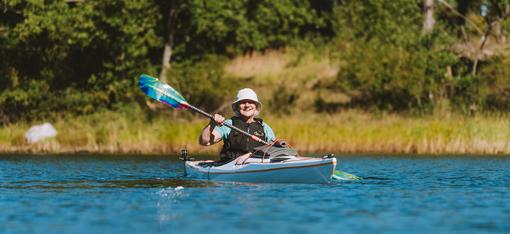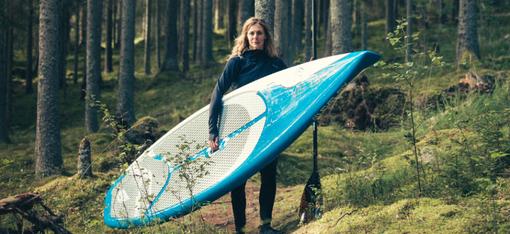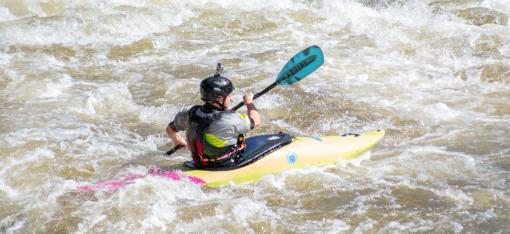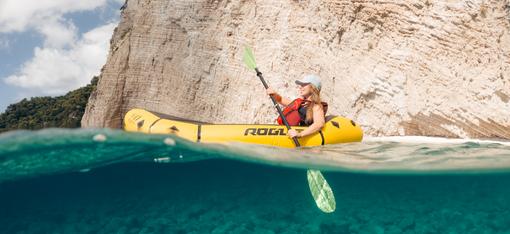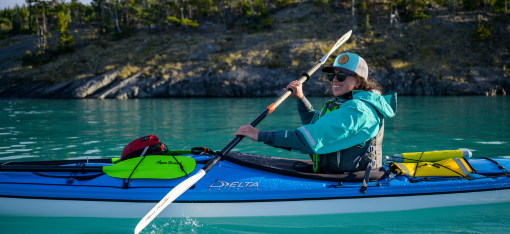Kayaking the Stikine - the “Everest of Whitewater”
8-minute read
British Columbia’s Stikine River sits just east of Alaska’s panhandle and about a hundred miles south of the Yukon provincial line. Often called “the Everest of whitewater,” kayaking the Grand Canyon of the Stikine was a dream trip for Thomas Franco.

Part of the group kayaks through 3 Goat (Photo courtesy of Thomas Franco)
After ten years of hoping and planning, Thomas’ realized his dream during the summer of 2024. He successfully kayaked the 72-kilometer Grand Canyon section with several other elite paddlers.
We asked Thomas to tell us about his experience in a recent interview:
AQUA BOUND: Why is the Stikine River often called "the Everest of whitewater”?
THOMAS: First is the difficulty. The 72 kilometers of the canyon section is a continuous stretch of Class 5 whitewater. It’s truly wilderness expedition-style kayaking. Over the years, technology, experience and knowledge have allowed kayakers to do it more efficiently, but historically it’s an overnighter. It could take between 2-3 days to paddle.
Some of the top-tier of the elite kayaker category can do it very efficiently. Some do it in a day. Some do more than one trip down in a day. But that’s the 0.1%—which is interesting because most Class 5 kayakers are already within the 0.1% of the kayaking population.
Second, it’s extremely remote. From personal experience, it’s about a 20-24 hour drive north of the Canadian border. And it’s 12 hours from the nearest legitimate healthcare system, although there are small towns in between.
Then, there are very few places where you can exit the river safely and hike out if you need to (say, in an emergency situation). And if you were to make that decision, there are the elements and the wildlife—this is very much grizzly bear country. It would be a daunting task to decide to leave the Canyon once you start down.

Steep canyon walls surround the Stikine River (photo courtesy of Thomas Franco)
So those three factors make it the perfect recipe. From having experienced it myself, I can understand the category it gets put into.
AQUA BOUND: Was this your first trip down the Stikine?
THOMAS: Yes. I have been trying to accomplish this for 8-10 years. Ever since I’ve known about this river, I’ve had my eyes set on achieving it.
As a group, we decided to go down in two days and camp about halfway down the whitewater section. Then there’s about a 20-kilometer paddle out with Class 2, 3 and one Class 4 at the start of the paddle out.
We had a lot of time after the whitewater on Day 1 to relax at a really beautiful campsite. It’s known as “wolf tracks,” where you’re tucked away in a little bit of an opening. The river opens up a little below a rapid called Garden of the Gods if that paints any sort of picture.

3 of the group members head down Garden of the Gods (photo courtesy of Thomas Franco)
AQUA BOUND: What were your biggest challenges?
THOMAS: The biggest challenge was staying mentally present the entire time. There were some moments in the river when we encountered some really challenging whitewater and it resulted in some having to wet exit their boats. Having to “wet exit” is called a “swim” in the kayaking world, as it would suggest.
Fortunately, we were able to rescue the paddler and all the gear so it ended up working out. All things considered, it was a very efficient rescue and all smiles at the end of the day. That speaks to the testament of having a really solid group of kayakers you trust.
My buddy Ry and I had been in British Columbia for three weeks prior, paddling the whole time. We started in Whistler, paddled the Ashlu Box Canyon, the Cheakamus and the Callaghan Rivers, then worked our way up to Clearwater. We paddled some overnighters on the Clearwater, which was a great idea. It gave us an introduction to the magnitude and volume of whitewater we were going to be stepping into.
There are different styles of whitewater and the Stik and the Clearwater are characterized as “big water.” This means massive features like big waves, big holes and big hazards.

“Warming up” on Clearwater before they reach the Stikine (photo courtesy of Thomas Franco)
AQUA BOUND: What was your personal highlight of the trip?
THOMAS: The whole trip was a highlight in itself. It was very surreal being in a place I had dreamt of being in for almost a decade. Having been able to experience that in real time and document it so well made it the trip of a lifetime for me.
Another highlight was knowing I had prepared myself well. I was physically capable. My technical skills as a whitewater paddler were there. I felt prepared. That’s not to say I felt comfortable—but it just felt right. It was enjoyable. Obviously, there are elements of fear, but I was within my realm of capability, which was a highlight for me.
AQUA BOUND: Tell us more about your group.
THOMAS: Half the group had never paddled the river and half had already been down it at least once. Some had been down multiple times. We were fortunate enough to have people who knew where the rapids were and where to be in most of the rapids. Some of the rapids had changed so there was an element of uncertainty, which there typically always is.

The Stikine was new for half the group (photo courtesy of Thomas Franco)
The group melded together in a piecemeal fashion. I had been conversing with a handful of people throughout the summer, trying to figure out people’s interest. I linked up with a paddle whose name is Rye Hester And I had been in contact with another, Tyler, for a few months, trying to figure out if we would be able to line up water levels with people’s schedules. That’s definitely the hardest part.
To be quite frank, I had attempted this same expedition two years prior but got stunted. I went up and the water was too high for our first trip. We had to drive all the way back down. I was determined not to let that happen again.
That experience made our successful trip even more meaningful, I think—to actually accomplish it. I’m glad I stepped away from that trip and made the decision to wait. Now having paddled it at the water levels we had, I think I would’ve been a lot more scared going in there at higher water. It was above the recommended height for your first time. So getting the logistics right this time was very important.

Thomas takes on Scissors on the Stikine (photo courtesy of Thomas Franco)
Back to the group—I didn’t know the majority of them prior to our trip. I was basing a lot of it off of reputation. Most people aren’t putting on that river without knowledge of it, so I put some trust in people I had maybe only paddled with once before. I was also going off Tyler’s word, which I trust beyond most people in the kayaking world.
AQUA BOUND: Tell us a little of your kayaking background.
THOMAS: I started with baby steps and worked my way up slowly but surely into more challenging whitewater. That started in Richmond, Virginia where I grew up going to summer camps and paddling the Class 2 and 3 whitewater on the James River.
Then in the falls and winters, the river floods and it turns into more of Class 3 and 4 technicality. That gave me the opportunity to learn the ropes, learn the safety and learn the skills I needed to then move into the Class 5 whitewater very nearby.
I also had the Great Falls of the Potomac River, which I consider my Class 5 stomping grounds. It’s a couple of hours from Richmond up in DC, on the East Coast. That’s a really great river and environment to learn how to paddle Class 5. Anyone who knows the James or the Great Falls can attest to that.
I spent the first 23 years of my life there and was very immersed in that kayaking community. I traveled up and down the East Coast, eventually making my way out west, into Central America and other places to kayak. I caught the bug! I really started seeing what was possible and started pushing my personal limits.

Thomas Franco on one of his whitewater adventures (photos courtesy of Seth West)
I would say I’m within a cohort of whitewater paddlers who had it easy because the people who came before me were really revolutionizing the sport and evolving it. That gives endless resources to figure out take-outs, put-ins, water levels, learn different techniques and find other people to paddle with on social media and things like that.
I tip my hat to all the generations of kayakers before me and especially the ones who entered the Stikine first.
AQUA BOUND: You used our Aerial paddle on the Stikine. How did it perform for you?
THOMAS: I’m really grateful I had the opportunity to use this paddle. The paddle is the quintessential part of the kayaking experience, along with the kayak. So that piece of gear is integral. You really want to be able to trust it because it’s what’s propelling you down the river, helping you navigate some of these experiences, quite literally. I had a blast with it. In fact, I’m going to start using it as my daily paddle.

Thomas’ whitewater paddle, Aqua Bound’s Aerial Major (photo courtesy of Seth West)
The model I have is the 2-piece carbon (Aerial Major) with the Versa-Lok™ ferrule that allows you to adjust the paddle offset and the length. That’s super helpful because you can quickly adjust the paddle to fit your needs. In big water, I don’t always want a longer paddle. I can get away with less length and that helps with the torque on my shoulders. Then when I’m trying to go fast, with maybe some racing in the future, I’ll likely lengthen it to get a little more leverage and pull.
It’s really an exciting paddle. I can attest to its sturdiness. I’ve been using it since June and it pretty much looks like it did when I got it. It helped me make the decision pretty quickly to hop on board with Aqua Bound.
You can follow Thomas on his Instagram page for more.
What paddling questions can our friendly Customer Service team help you with? Contact us at 715-755-3405 or sales@aquabound.com
More for you...

